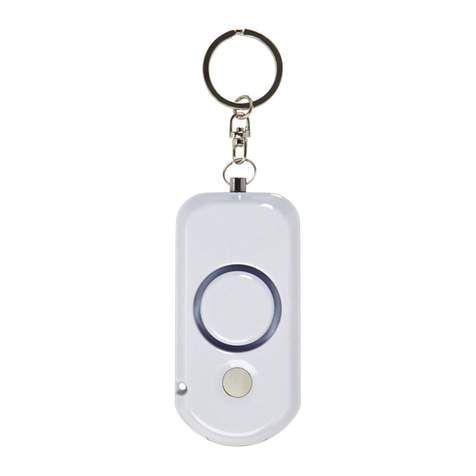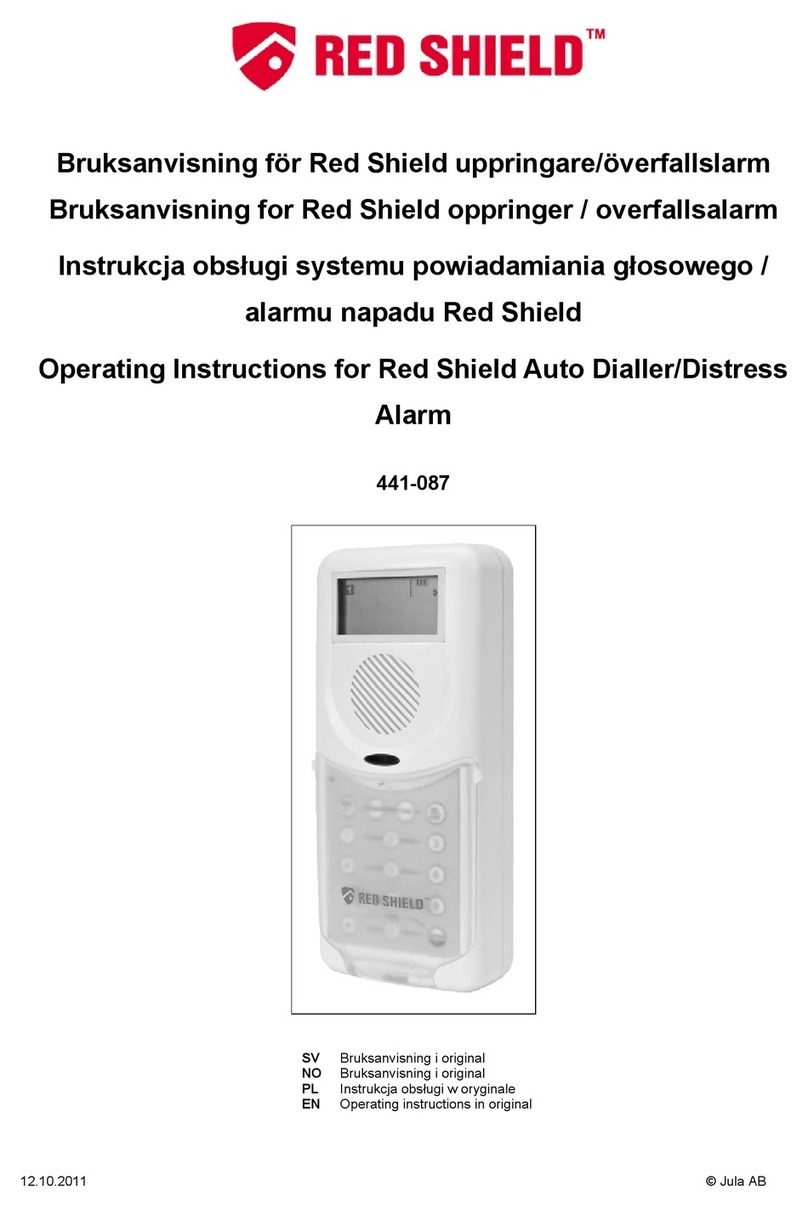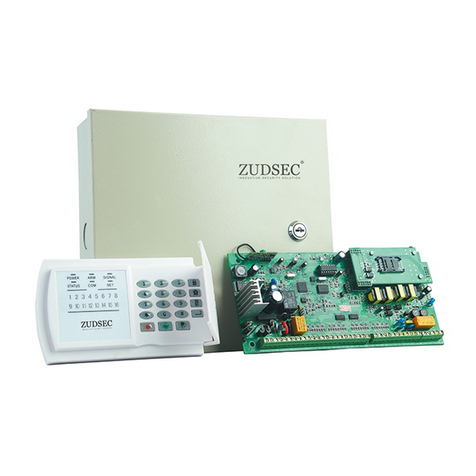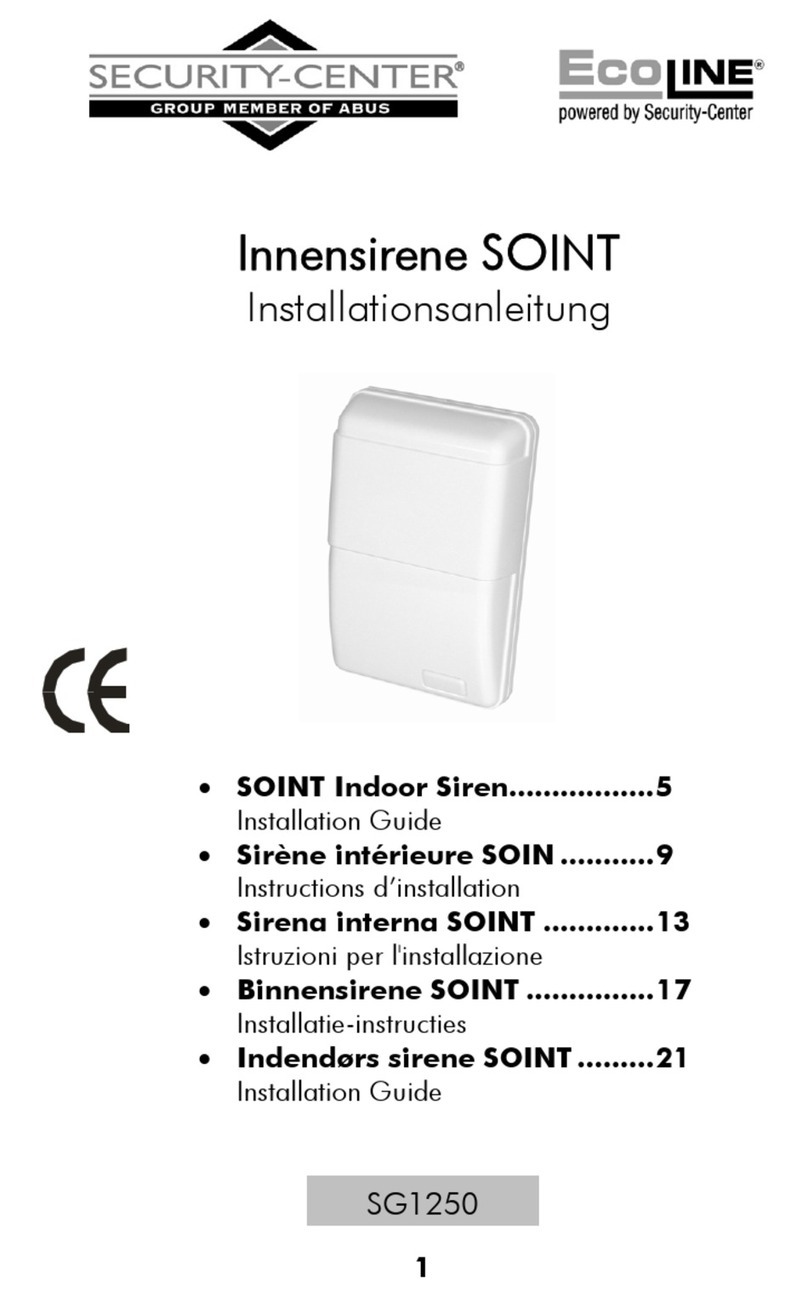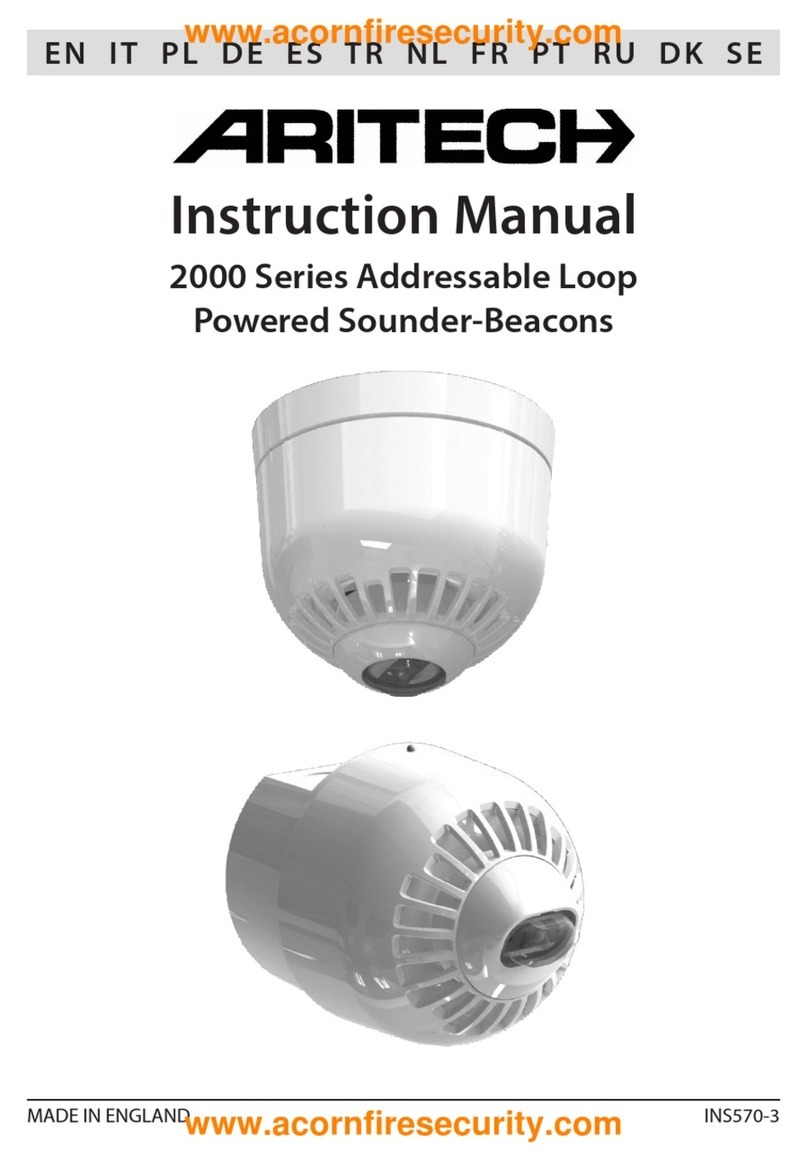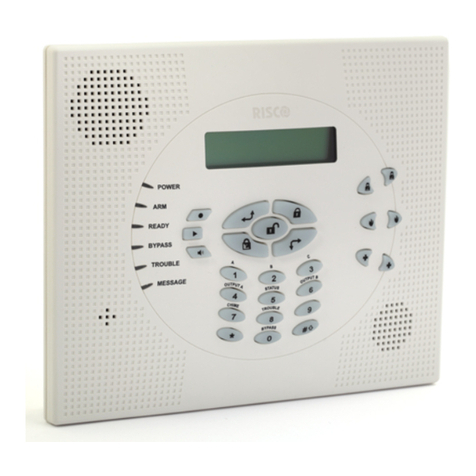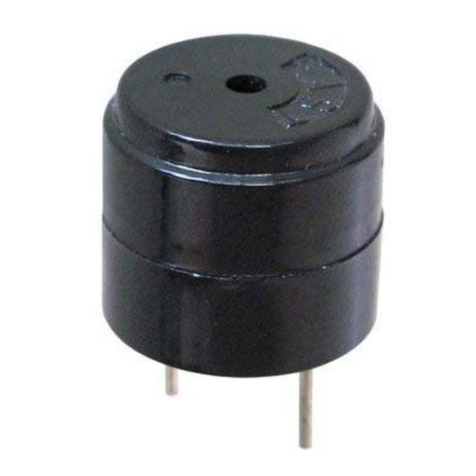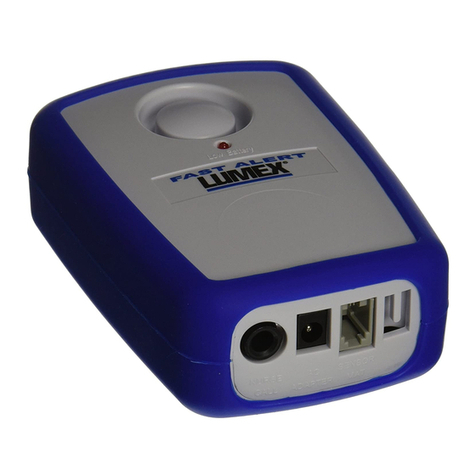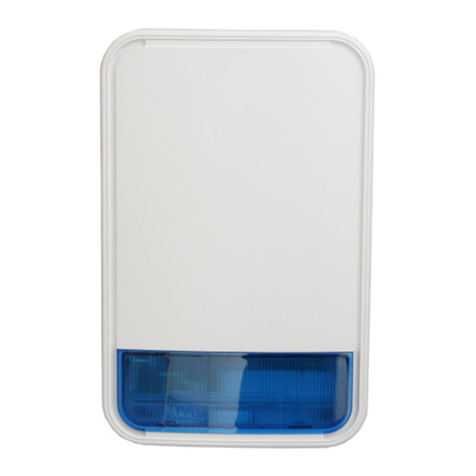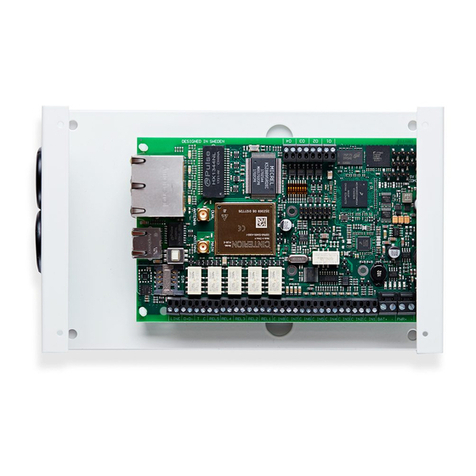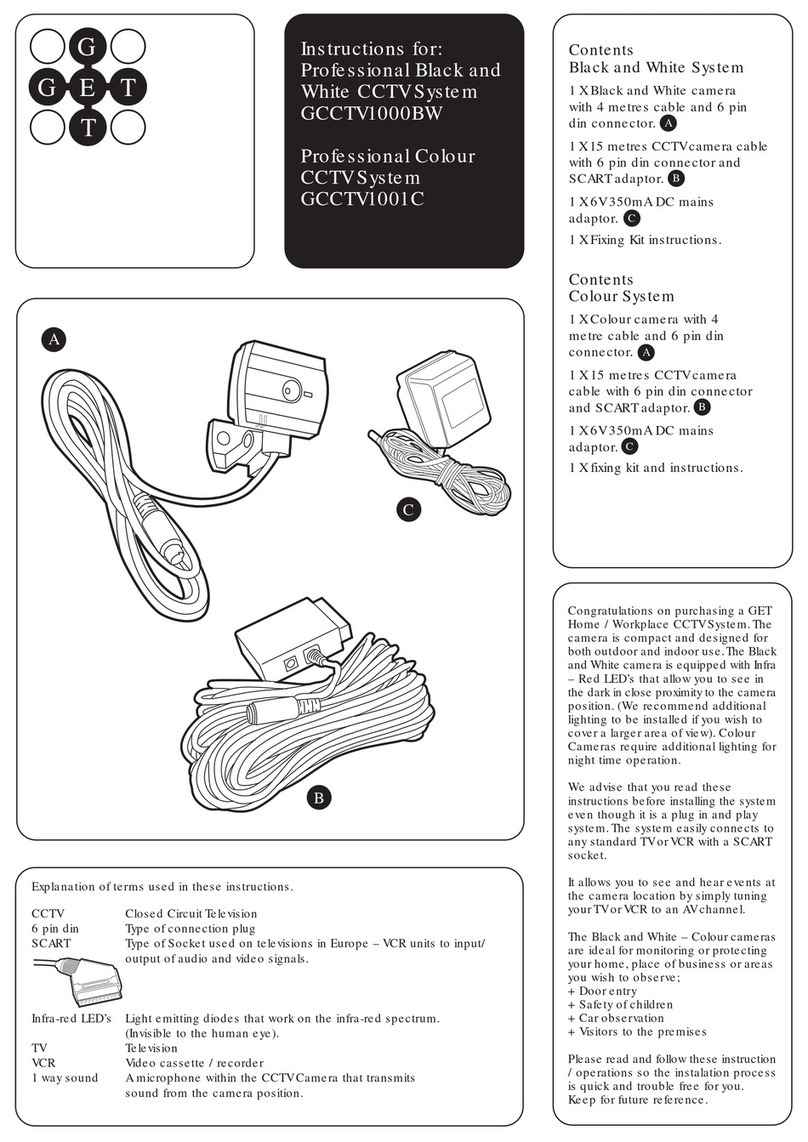Clas Ohlson AEI AC-238 User manual

ENGLISH SVENSKA NORSK SUOMI
32-5168
Alarm Control Box
Model: AEI AC-238


3
ENGLISH
3
Alarm control box AEI AC-238
with control module for 2 sections
Art. no: 32-5168
Please read the entire instruction manual before using and save it for future use.
We apologise for any text or photo errors and any changes of technical data.
If you have any questions concerning technical problems please contact our Customer
Service Department (see address on reverse.)
Introduction
This alarm control box is intended as a protection for week-end houses, caravans and
boats. It has two independent protective loops which are instant or delayed. The loops
(both instant and delayed) have an end resistance as circuit control. In addition they
can work together with a so-called N.O. indicator (with a connecting function) and N.C.
indicators (with a disconnecting function).
Alarm output to power two 8 ohm horn speakers and it has a 12 V DC 5 A relay
output. This is built into the alarm control module. Furthermore there is a 30 second
input delay and a set 60 second output delay, a siren timer which switches off after 3
minutes and a separate scanning control for instant and delayed loops.
In standby mode the alarm centre uses very little power and therefore it ts perfectly
into a battery operated protection system.
Connection
terminals
Terminals
cover
Exit indicator
Alarm on/off
switch
Mounting
screw holes
Control module

ENGLISH
1 - 2
INSTANT LOOP
This circuit trips the alarm IMMEDIATELY.
It can be used together with an alarm
annunciator with both a connecting (N.
C.) and a disconnecting (N. O.) function.
Connection point 1 is the sensor point and
connection point 2 is the common earthing
point. Connect N. C. connectors in series and
N. O. connectors in parallel. An end resistance
of 10 kOhm must be connected in series to
the circuit to seal it. The circuit is excellent for
magnetic contacts, panic buttons, pressure
carpets and surroundings protection.
3 - 4 DELAYED LOOP
This circuit offers an input delay to trigger
the alarm. It is especially suitable for motion
detectors (e.g. IR detectors) and other
sensors which require delays. The circuit can
be used together with both N. O. and N. C.
components. Connection point 3 is the sensor
point and point two is the common earthing
point. Connect N. C. sensors in series and
N.O. sensors in parallel. An end resistance of
10 kOhm must be connected in series to the
circuit to seal it.
Without delay
With delay
Horn speakers
Loudspeaker output - Horn speakers (4 - 5)
A maximum of two 8 Ohm horn speakers can
be connected in parallel to these connection
points. Point 4 is the output for the siren power
and point 5 is the common plus point for the
entire alarm centre.
Notes
a. If any of the protection circuits do not use a N. C. sensor, a 10 kOhm resistor must
be connected to the circuit (sensor point and common earthing point).
b. The end resistance is connected to the end of the N. C. circuit. We recommend
that it is connected furthest away in the alarm loop. The resistance prevents the N.
C. circuit from being disarmed by the sensor cable being short circuited. Such an
attempt would trigger the alarm.
c. To ensure normal function in the N. C. circuits the maximum circuit resistance in
every circuit should be less than 1 kOhm.
Connection points

5
ENGLISH
Installation
1. Choose a discrete place for the alarm
centre that lies close at hand so that
you can comfortably disconnect the
alarm in less than the 30 seconds which
the input delay lasts.
2. Choose the zone which needs
protection. Usually:
• passages between houses,
• rooms containing valuables,
• openings which offer a possible
entrance point for breaking and
entering.
3. When you have chosen a suitable
place for the alarm centre and decided
which zones you want to monitor you
can start drawing the wire for the alarm
system using the installation diagram.
Do not connect a live conductor to the
alarm centre while drawing the wires.
4. When you have completed drawing the
wires, ensure that all connections have
been made correctly before switching
the power to the alarm centre on.
Connect the negative (-) pole to point
7 and the positive (+) pole to point 8.
N. O. relay contact (6)
Connection point 6 is connected to a N.
O. relay contact which closes the circuit
and connects point 6 to a plus pole when
the alarm is tripped. The contact triggers
when the siren time ends. It is suitable for
activating other equipment such as door
bells powered by direct-current, ashes,
alarms, number transmitters etc. Connect
each component with plus poles to point 6
and minus poles to point 7.
Power connection (7 - 8)
The alarm control box is intended to be
powered by 12 - 16 V DC. Connect the
negative (-) pole to point 7 and the positive
(+) pole to point 8.
Testing & use
1. Close all doors and windows to
ensure that all N. O. and N. C. circuits
are in their standard position.
2. Turn the switch to ON. The output delay
and light-emitting diode EXIT start to
blink. After approx. one minute the
alarm is activated and the light-emitting
diode EXIT switches off. If a protection
circuit is abnormal the light-emitting
diode is lit but it does not blink. If that is
the case, check the wires and that the
windows and doors which are tted with
alarm contacts are properly closed.
3. Try opening the door which is
connected to the delay circuit. It takes
30 seconds before the alarm is tripped.
4. Try opening the door or window which
is connected to the instant loop. The
alarm is triggered immediately.
5. After the alarm has been tripped the siren
and relay contacts come into function.
They are reset automatically after the time
out which takes approx. 3 minutes.
6. You can switch the alarm off
whenever you want to by turning the
power switch to off.

6
ENGLISH
Suggestions for a protection system at home
8 ohm
horn speaker
Telephone dialer or
other alarm device
8 ohm
horn speaker
Strobe light
Magnetic switch
for main door
protection
Battery
Magnetic switches for
windows and side door
protection
Delayed loop
500 mA
transformator
Instant loop
Panic button
Infra red sensor Motion sensor for
interior protection
Delayed loop
10 K 10 K
Data
Delayed exit loop: 60 seconds
Delayed entrance loop: 30 seconds
Signal length siren: 3 minutes
Siren output: Driver max. two 8 Ohm loudspeakers
Output using a relay contact: A N. O. 12 V DC 5 A relay contact
Connection points for sensors: One delayed loop and one instant loop for N. O. and N. C.
Power: 12 - 16 V DC
Measurements in mm: 87 x 120 x 33
Weight: 145 grams
The manufacturer reserves the right to make changes without any prior notice.
Disposal
Follow local ordinances when disposing of this product.
If you are unsure about how to dispose of this product contact your municipality.

SVENSKA
Larmcentral AEI AC-238 med styrmodul för 2 sektioner
Art. no: 32-5168
Läs igenom hela bruksanvisningen före användning och spara den sedan för framtida
bruk. Vi reserverar oss för ev. text- och bildfel samt ändringar av tekniska data. Vid
tekniska problem eller andra frågor, kontakta vår kundtjänst (se adressuppgifter på
baksidan).
Introduktion
Denna larmcentral är avsedd som skydd för fritidshus, husvagnar och båtar.
Den har två av varandra oberoende larmkretsar med resp utan fördröjning. Kretsarna
(både utan och med fördröjning) har ett slutmotstånd som kretskontroll. Dessutom kan
de fungera tillsammans med s. k. N.O.- avgivare (med slutande funktion) och N.C.
- avgivare (med brytande funktion).
Larmutgång för att driva 2 st. 8 ohms hornhögtalare och en 12 V DC 5 A
reläutgång. Detta är inbyggt i larmets styrmodul. Vidare nns en fast 30 sekunders
ingångsfördröjning och en fast 60 sekunders ut-gångsfördröjning, en sirentimer som
slås av efter 3 minuter samt en separat kontroll av kretsar med och utan fördröjning.
I aktiveringsläge (standby) drar larmcentralen ytterst lite ström och den passar därför
utmärkt i ett batteridrivet skyddssystem.
Avslutnings-
punkter
Täckpanel
Utgångsindikator
Strömbrytare
(larm)
Fästhål
Styrmodul

8
SVENSKA
Krets utan fördröjning (1-2)
(INSTANT LOOP)
Denna krets utlöser larmet OMEDELBART.
Den kan användas tillsammans med
larmgivare med både brytande (N.C.) och
slutande (N.O.) funktion. Inkopplingspunkt
1 är den avkännande punkten och
inkopplingspunkt 2 är gemensam
jordningspunkt. Koppla N.C. kontakter i serie
och N.O. kontakter parallellt. Ett slutmotstånd
på 10 kOhm måste kopplas in i serie med
kretsen för att försegla den. Kretsen lämpar
sig utmärkt för magnetkontakter, nödknappar
och tryckmattor.
Krets med fördröjning (2-3)
(DELAYED LOOP)
Denna krets erbjuder ingångsfördröjning för
att utlösa larmet. Den är synnerligen lämplig
för rörelsedetektorer ( t. ex. IR-detektorer
) och andra givare som kräver fördröjning.
Kretsen kan användas tillsammans med
både N. O och N. C. givare. Inkopplingspunkt
3 är den avkännande punkten och punkt 2
är gemensam jordningspunkt. Koppla N. C.
givare i serie och N. O. givare parallellt. Ett
slutmotstånd på 10 kOhm måste kopplas in
i serie med kretsen för att försegla den.
Utan fördröjning
Med fördröjning
Hornhögtalare
Högtalarutgång - Hornhögtalare (4 - 5)
Max. 2 st. 8 ohms hornhögtalare kan anslutas
parallellt till dessa inkopplingspunkter. Punkt
4 är utgången till högtalaren och punkt 5
är den gemensamma pluspunkten för hela
larmcentralen.
Anmärkningar:
a. Om någon av skyddskretsarna inte använder N. C. givare, måste ett 10
kOhm motstånd kopplas in över kretsen (avkänningspunkt och gemensam
jordningspunkt).
b. Slutmotståndet kopplas in i slutet av N.C.kretsen. Vi rekommenderar att det kopplas
in längstbort i larmslingan. Motståndet förhindrar att N. C.kretsen oskadliggörs
genom kortslutning av avkännande kabel. Ett sådant försök skulle utlösa larmet.
c. För att säkerställa normal funktion i N. C. kretsarna bör max. kretsresistans i varje
krets ligga under 1 kOhm.
Anslutningspunkter

SVENSKA
Installation
1. Välj ut en diskret plats som ligger nära
till hands för larmcentralen så att larmet
bekvämt kan slås av under de 30 sek
som ingångsfördröjningen varar.
2. Välj ut den zon som kräver skydd.
Vanligtvis är det:
• passager mellan hus
• rum som innehåller dyrbarheter
• mot utsidan vända öppningar
som erbjuder tänkbart tillträde för
inbrottstjuvar.
3. När du valt ut en lämplig plats för
larmcentralen och sett ut de zoner
du vill övervaka kan du börja dra
ledningar för larmsystemet med hjälp
av installationsdiagrammet. Koppla
inte in någon strömförande ledare till
larmcentralen medan du drar kablarna.
4. När du är klar med tråddragningen
kontrollerar du att alla anslutningar
är korrekt gjorda innan du slår på
strömmen till larmcentralen. Anslut
inkopplingspunkt 7 till negativ ledare
(–) och inkopplingspunkt 8 till positiv
(+) ledare.
N. O. reläkontakt ( 6 )
Inkopplingspunkten 6 är en N. O.
reläkontakt som sluter kretsen och ansluter
punkt 6 till en plusspänning när larmet
utlöses. Kontakten slår ifrån när larmtiden
tar slut. Den passar för aktivering av
annan utrustning som t. ex. ringklocka
som drivs med likspänning, blixtljus,
larmuppringare, nummersändare osv.
Anslut resp. komponent med plusledare till
punkt 6 och minusledare till punkt 7.
Ingång för drivspänning (7 - 8)
Larmcentralen är avsedd att drivas med
12 - 16 V DC. Anslut negativ (–) ledare till
punkt 7 och positiv (+) ledare till punkt 8.
Testning & användning
1. Stäng alla dörrar och fönster för att
säkerställa att alla N. O. och N. C.
kretsar står i normalläge.
2. Ställ strömbrytaren på ON. Då
börjar utgångsfördröjningen och
lysdioden EXIT (utgång) blinkar.
Efter ca en minut är larmet aktiverat
och lysdioden EXIT är släckt. Om
någon skyddskrets är onormal så är
lysdioden tänd men den blinkar inte.
Kolla i så fall tråddragningen och att
de fönster och dörrar som är försedda
med larmkontakter är riktigt stängda.
3. Försök att öppna den dörr som är
ansluten till fördröjningskrets. Det tar
30 sekunder innan larmet utlöses.
4. Försök att öppna den dörr eller det
fönster som är ansluten till krets
utan fördröjning. Larmet utlöses
omedelbart.
5. Efter att larmet utlösts träder
högtalardrivare och reläkontakt
i funktion. De återställs automatiskt
efter ca 3 minuter.
6. Du kan när som helst stänga larmet
genom att ställa strömbrytaren på off.

10
SVENSKA
Förslag till skyddssystem för ett hem
8 ohms
högtalare
Larmuppringare eller
annan larmapparat
8 ohms
högtalare
Blixtljus
Magnetkontakt
för skydd av
ytterdörr
Batteri
Magnetkontakter
för dörrar och fönster
Slutmotstånd
500 mA
transformator
Krets utan
fördröjning
Nödknapp
IR-detektor Rörelsedetektor för
skydd inomhus
Slutmotstånd
10 K 10 K
Data
Utgångsfördröjning: 60 sekunder
Ingångsfördröjning: 30 sekunder
Larmtid: 3 minuter
Högtalarutgång: Driver max. två 8 -Ohms högtalare
Utgång med reläkontakt: En N.O. 12 V DC 5 A reläkontakt
Inkopplingspunkter för givare: En krets med, en utan fördröjning för N.O. & N.C.
Drivspänning: 12 - 16 V DC
Mått i mm: 87 x 120 x 33
Nettovikt: 145 gram
Tillverkaren förbehåller sig rätt till ändringar utan föregående meddelande.
Avfallshantering
När du ska göra dig av med produkten ska detta ske enligt lokala föreskrifter.
Är du osäker på hur du ska gå tillväga, kontakta din kommun.

11
NORSK
Alarmsentral AEI AC-238 med styremodul for 2 kretser
Art. no: 32-5168 • Model AEI AC-238
Les nøye igjennom hele bruksanvisningen og ta vare på den til senere bruk.
Vi reserverer oss mot ev. tekst- og bildefeil, samt forandringer av tekniske data.
Ved tekniske problemer eller andre spørsmål, ta kontakt med vårt kundesenter
(se opplysninger på baksiden).
Introduksjon
Denne alarmsentralen er beregnet for beskyttelse av fritidsboliger, campingvogner og
båter. Den har to separate alarmkretser uten forsinkelser. Kretsene (både uten og med
forsinkelse) har en sluttmotstand som kretskontroll. De kan dessuten fungere sammen
med N.O.-givere (med lukket funksjon) og N.C.-givere (med brutt funksjon).
Alarmutgang for å drive 2 stk. 8 ohms hornhøyttalere og en 12 V DC, 5 A relèutgang.
Dette er innebygd i alarmens styringsmodul. Videre nnes det en fast 30 sekunders
inngangsforsinelse, og en fast 60 sekunders utgangsforsinkelse, en sirenetimer, som
slås av etter 3 minutter, samt en separat kontroll av kretser med og uten forsinkelse.
I aktiv posisjon (standby) bruker alarmsentralen meget lite strøm, og den passer derfor
utmerket i et batteridrevet system.
Koblingspunkter
Deksel
Utgangsindikator
Strømbryter
(alarm)
Festehull
Styremodul

12
NORSK
Krets uten forsinkelse (1 – 2)
(INSTANT LOOP):
Denne kretsen utløser alarmen
UMIDDELBART. Den kan brukes sammen
med alarmgivere med både brutt (N.C.) og
lukket (N.O.) funksjon. Innkoblingspunkt 1 er
sensorpunktet og innkoblingspunkt 2 er et
felles jordingspunkt. Koble N.C. kontakter i
serie og N.O. kontakter parallelt. En motstand
på 10 kOhm må kobles inn i serie med
kretsen, for å lukke den. Kretsen egner seg
utmerket for magnetkontakter, nødbrytere og
kontaktmatter.
Krets med forsinkelse (2 – 3)
(DELAYED LOOP):
Denne kretsen har inngangsforsinkelse
før utløsing alarm. Den egner seg for
bevegelsesdetektorer (f.eks. IR-detektorer) og
andre givere som krever forsinkelse. Kretsen
kan brukes sammen med både N.O. og N.C.
givere. Innkoblingspunkt 3 er sensorpunktet
og punkt 2 er et felles jordingspunkt. Koble
N.C. givere i serie og N.O. giverne parallelt.
En motstand på 10 kOhm må kobles i serie
med kretsen for å lukke den.
Uten forsinkelse
Med forsinkelse
Hornhøyttalere
Høyttalerutgang - Hornhøyttalere (4 – 5)
Maks. 2 stk. 8 Ohms hornhøyttalere kan kobles
parallelt til disse innkoblingspunktene. Punkt
4 er utgangen til høyttaler, og punkt 5 er felles
plusspunkt for hele alarmsentralen.
Anmerkninger:
a. Dersom noen av beskyttelseskretsene ikke bruker N.C. givere, må en 10 kOhm
motstand kobles inn over kretsen (sensorpunkt og felles jordingspunkt).
b. Sluttmotstanden kobles inn i enden av N.C. kretsen. Vi anbefaler at den kobles inn
lengst ute i alarmkretsen. Motstanden forhindrer at N.C. kretsen uskadeliggjøres
ved kortslutning av følende kabel, noe som ville utløst alarmen.
c. For å sikre normal funksjon i N.C. kretsene, bør maks. kretsresistanse i hver krets
ligge under 1 kOhm.
Tilkoblingspunkter

13
NORSK
Installasjon
1. Velg ut en diskret plass for sentralen,
som samtidig er lett tilgjengelig for deg
når du skal deaktivere alarmsentralen
innen forsinkelsestiden på 30 sekunder.
2. Velg ut det område som trenger
beskyttelse.
Vanligvis er det:
• Passasjer mellom hus
• Rom med verdisaker eller
verdifulle gjenstander
• Mot mulige inngangsområder for
inntrengere.
3. Når du har valgt ut et passende område
for alarmsentralen, og har sett ut
områder du vil overvåke, kan du starte
med å trekke ledninger for systemet
med hjelp av installasjonsdiagrammet.
Ikke koble til strømførende ledere mens
du trekker kablene.
4. Når ledningene er trukket må alle
tilkoblingspunkter kontrolleres før du
tilfører systemet strøm. Koblingspunkt
7 kobles til negativ leder (-) og
koblingspunkt 8 til positiv leder (+).
N.O. relèkontakt ( 6 )
Inkopplingspunkten 6 är en N. O.
Innkoblingspunkt 6 er en N.O. relèkontakt
som slutter kretsen og kobler punkt 6 til
en plusspenning når alarmen løses ut.
Kontakten kobles ut når alarmtiden er ute.
Den passer til annet utstyr, som f.eks.
ringeklokke som drives med likespenning,
blitzlys, alarmoppringer, nummersender
etc. Koble respektive komponenter med
plussleder til punkt 6 og minuslederen til
punkt 7.
Inngang for drivspenning (7 – 8)
Alarmsentralen skal drives med 12 – 16 V
DC. Koble negativ leder (-) til punkt 7, og
positiv leder (+) til punkt 8.
Testing og bruk
1. Steng alle dører og vinduer, for å
sikre at alle N.O. og N.C. kretser er
i normalposisjon.
2. Still strømbryteren på ON. Da vil
utgangsforsinkelsen starte, og
lysdioden EXIT (utgang) blinker.
Etter ca. 1 minutt er alarmen aktivert
og lysdioden EXIT slukkes. Dersom
en av beskyttelseskretsene er
unormal, vil lysdioden være tent,
men den blinker ikke. Sjekk i så
fall ledningstrekket og at vinduer
og dører, som er utstyrt med
alarmkontakter, er helt stengt.
3. Åpne døren, som er koblet til
forsinkelseskretsen. Det tar 30
sekunder før alarmen løses ut.
4. Åpne en dør eller et vindu, som er koblet
til kretsen som ikke har forsinkelse.
Alarmen utløses umiddelbart.
5. Etter at alarmen er løst ut, trer
relèkontakten og høyttalerdriveren
i kraft. De tilbakestilles automatisk
etter ca. 3 minutter.
6. Når som helst kan alarmen skrus av
ved å skru strømbryteren på OFF.

1
NORSK
Forslag til beskyttelsessystem i hjemmet
8 ohms
høyttaler
Alarmoppringer eller
annet alarmapparat
8 ohms
høyttaler
Blitzlys
Magnetkontakt
för skydd av
ytterdörr
Batteri
Magnetkontakter for
dører og vinduer
Sluttmotstand
500 mA
transformator
Krets uten
forsinkelse
Nødknapp
IR-detektor Rörelsedetektor för
skydd inomhus
Sluttmotstand
10 K 10 K
Spesikasjoner
Utgangsforsinkelse: 60 sekunder
Inngangsforsinkelse: 30 sekunder
Alarmtid: 3 minutter
Høyttalerutgang: Driver maks. 2 stk. 8-Ohms høyttalere
Utgang med relèkontakt: En N.O. 12 V DC, 5 A relèkontakt
Innkoblingspunkter for givere: En krets med og en krets uten forsinkelse for N.O. & N.C.
Spenning: 12 – 16 V DC
Mål i mm: 87 x 120 x 33
Nettovekt: 145 gram
Produsenten forbeholder seg rett til å forandre uten varsel.
Avfallshåndtering
Når du skal kvitte deg med produktet, skal dette skje i henhold til lokale forskrifter.
Er du usikker på hvordan du går fram, ta kontakt med lokale myndigheter.

15
SUOMI
Hälytyskeskus AEI AC-238 ja 2-jaksoinen ohjausmoduli
Art. no: 32-5168
Lue käyttöohjeet ennen tuotteen käyttöönottoa. Säilytä käyttöohjeet tulevaa tarvetta
varten. Pidätämme oikeuden teknisten tietojen muutoksiin. Emme vastaa mahdollisista
teksti- tai kuvavirheistä. Jos laitteeseen tulee teknisiä ongelmia, ota yhteys myymälään
tai asiakaspalveluun (yhteystiedot käyttöohjeen lopussa).
Yleistä
Tämä edullinen ja kompakti hälytyskeskus on tarkoitettu pienehköjen kohteiden
(esim. asuntojen, kulkuvälineiden ja veneiden) suojaukseen. Siinä on kaksi toisistaan
riippumatonta suojauspiiriä (suora sekä viiveellinen). Piireissä (sekä viiveellisessä että
suorassa) on piirin kuntoa valvovat suojavastukset. Tämän lisäksi ne toimivat sekä
N.O.-antureilla (sulkeutva piiri) ja N.C.-antureilla (avautuva piiri).
Sireeniä varten oleva ulostulo voi ohjata kahta 8 Ohm:n torvikaiutinta. Toiminto on
sisäänrakennettu hälyttimen ohjausmoduuliin. Sisääntuloviive on kiinteä, 30 sekuntia,
ja ulosmenoviive kiinteä, 60 sekuntia. Sireeni sammuu 3 minuutin jälkeen. Erillinen
piirien (viiveellisen ja viiveettömän) kunnonvalvonta.
Valmiustilassa (Standby-asennossa) hälytyskeskus kuluttaa äärimmäisen vähän virtaa.
Tämän takia sen voi liittää erinomaisesti akkukäyttöiseen suojausjärjestelmään.
Liitoskohdat
Peitelevy
Ulosmenoilmaisimet
Katkaisija
(hälytin)
Kiinnitysreiät
Ohjausmoduli

16
SUOMI
1 - 2 Piirit ilman viivettä
(INSTANT LOOP)
Tämä piiri hälyttää VÄLITTÖMÄSTI. Tätä
voidaan käyttää yhdessä hälytinlaitteen
avautuvan (N.C.) ja sulkeutuvan (N.O.)
toiminnon kanssa. Liitoskohta 1 on
tunnistava kohta. Liitoskohta 2 on yhteinen
maadoituspiste. Yhdistä N.C.-liitokset
sarjaan ja N.O.-liitokset rinnakkain. Kytke
lopuksi sarjaan yksi 10 kOhm:n vastus.
Piiri sopii hyvin esim. magneettiantureille,
hätäpainikkeille ja painematoille.
3 -4 Piirit viiveellä
(DELAYED LOOP)
Tässä piirissä on sisääntuloviive ennen
hälytyksen laukaisua. Tämä soveltuu
erityisesti liiketunnistimiin (esim. IP-
tunnistimet) sekä muihin viivettä tarvitseviin
sisätilojen valvontalaitteisiin. Piiriä voidaan
käyttää yhdessä sekä N.O.- että N.C.-
yksiköillä. Liitoskohta 3 on tunnistava kohta
ja liitoskohta 2 on yhdysmaadoituspiste. Liitä
N.C.-laitteet sarjaan ja N.O.-laitteet rinnan.
Lopuksi piiriin pitää kytkeä sarjaan yksi 10
kOhm:n vastus.
Piiri ilman viivettä
Viiveellinen piiri
Torvikaiutin
4–5 Ulostuloliitännät torvikaiuttimille
Enintään kaksi 8 Ohm:n torvikaiutinta voidaan
liittää rinnakkain näihin liitospisteisiin. Liitos
4 on ulostulo sireenijännitteelle ja liitos 5 on
yhteinen pluspiste koko ohjausmoduulille/
hälytyskeskukselle.
Huom.!
a. Jos jokin suojauspiireistä ei käytä N.C.-katkaisijaa, täytyy 10 kOhm:n vastus kytkeä
piirin yli (tunnistuspiste ja yhteinen maadoituspiste).
b. E.O.L.-vastus on loppuvastus, joka liitetään N.C.-piirin loppuun. Suosittelemme,
että liität sen kauas liitospisteistä. Vastus suojaa N.C.-piiriä tunnistuspiirin
oikosululta. Se aiheuttaisi hälytyksen.
c. Jotta laite toimisi normaalisti, saa N.C.-piirin maksimivastus olla enintään 1 kOhm/
piiri.
Asennuskohdat

1
SUOMI
Asennus
1. Valitse hälytyskeskukselle
huomaamaton paikka, joka on kuitenkin
helposti tavoitettavissa 30 sekunnin
sisääntuloviiveen aikana.
2. Valitse suojausta tarvitsevat alueet.
Sellaisia ovat muun muassa
• yhdyskäytävät
• huoneet, joissa on arvotavaraa
• aukot, joista mahdollisen tunkeutuja
voisi tulla sisään.
3. Kun olet valinnut hälytyskeskukselle
sopivan paikan ja valinnut suojausta
tarvitsevat alueet, voit alkaa
hälytysantureiden johdotuksen
asennuskaavion avulla. Älä liitä mitään
virtajohtoja hälytyskeskukseen, kun teet
johdotuksia.
4. Tarkista johdotusten oikeellisuus ennen
virran kytkemistä hälytyskeskukseen.
Kytke liitoskohta 7 negatiiviseen
johtimeen (–) ja liitoskohta 8
positiiviseen (+) johtimeen.
6 N.O.-releliitäntä
Liitoskohta 6 liitetään N.O.-releliitäntään,
joka sulkee piirin ja liittää kohdan 6
plusvirtaan kun hälytys laukeaa. Yhteys
katkeaa, kun sireenihälytys loppuu.
Se sopii toisen laitteiston aktivointiin,
esim. tasavirralla toimivalle ovikellolle,
vilkkuvalolle, soittohälytykselle jne. Liitä
komponentin plusjohdin kohtaan 6 ja
miinusjohdin kohtaan 7.
7–8 Käyttöjännitteen sisäänmeno
Ohjausmoduli on tarkoitettu toimimaan
12–16 V:n DC-virralla. Liitä negatiivinen
(–) johdin kohtaan 7 ja positiivinen (+)
johdin kohtaan 8.
Testaus & käyttö
1. Sulje kaikki ovet ja ikkunat
tarkistaaksesi, että kaikki N.O.- ja
N.C.-piirit ovat normaalitilassa.
2. Aseta virtakytkin kohtaan ON.
Ulosmenoviive alkaa ja merkkivalo
EXIT (ulosmeno) vilkkuu. Noin
minuutin jälkeen hälytin aktivoituu ja
merkkivalo EXIT sammuu. Merkkivalo
palaa (ei vilku), jos jokin suojauspiiri
on epänormaali. Tarkista tässä
tapauksessa johdotus. Tarkista myös,
että hälytysjärjestelmään liitetyt ovet
ja ikkunat ovat kunnolla suljetut.
3. Avaa viivepiiriin liitetty ovi tai ikkuna.
Hälytys laukeaa 30 sekunnin kuluttua.
4. Avaa ovi tai ikkuna, joka on liitetty
sellaiseen piiriin, jossa ei ole viivettä.
Hälytys laukeaa välittömästi.
5. Hälytyksen jälkeen sireeni ja
relekontakti aktivoituvat. Ne
palautuvat automaattisesti noin 3
minuutin aktiivitilan jälkeen.
6. Voit sammuttaa hälytyksen koska
tahansa säätämällä katkaisijan OFF-
asentoon.

18
SUOMI
Ehdotus kodin suojausjärjestelmäksi
8 ohmin
kovaääninen
Soittohälytin tai muu
hälytyslaite
8 ohmin
kovaääninen
Vilkkuvalo
Magneetti-
anturit ulko-
ovien suojaukseen
Paristo
Magneettianturit
ikkunoille ja oville.
Loppuvastus
500 mA:n
muuntaja
Krets utan
fördröjning
Hätäpainike
Infrapuna-anturi Sisätilojen
liiketunnistin
Loppuvastus
10 K 10 K
Tekniset tiedot
Ulosmenoviive: 60 sekuntia
Sisääntuloviive: 30 sekuntia
Sireenin hälytysaika: 3 minuuttia
Sireeniulostulo: Enintään kaksi 8 Ohm:n kaiutinta
Releliitännän ulostulo: Yksi N.O. 12 V:n DC 5 A-releliitäntä (SPST)
Antureiden liitoskohdat: Yksi piiri ilman viivettä ja yksi piiri viiveellä N.O.- ja N.C.-antureille
Käyttöjännite: 12–16 V DC
Mitat millimetreinä : 87 x 120 x 33
Paino 145 grammaa
Valmistaja pidättää oikeuden tuotemuutoksiin ilman erillistä ilmoitusta.
Kierrätys
Kierrätä tuote asianmukaisesti, kun poistat sen käytöstä. Ota yhteys kuntasi
jäteneuvontaan, mikäli olet epävarma.
ViiVepiiri


SVERIGE
NORGE
SUOMI
GREAT BRITAIN
www.clasohlson.co.uk
customer service.
Table of contents
Languages:
Other Clas Ohlson Security System manuals
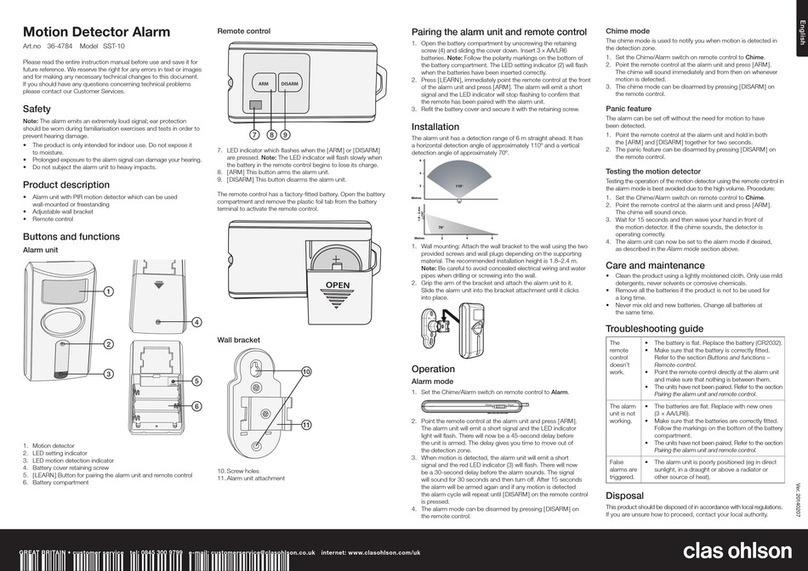
Clas Ohlson
Clas Ohlson SST-10 User manual

Clas Ohlson
Clas Ohlson IW001 User manual
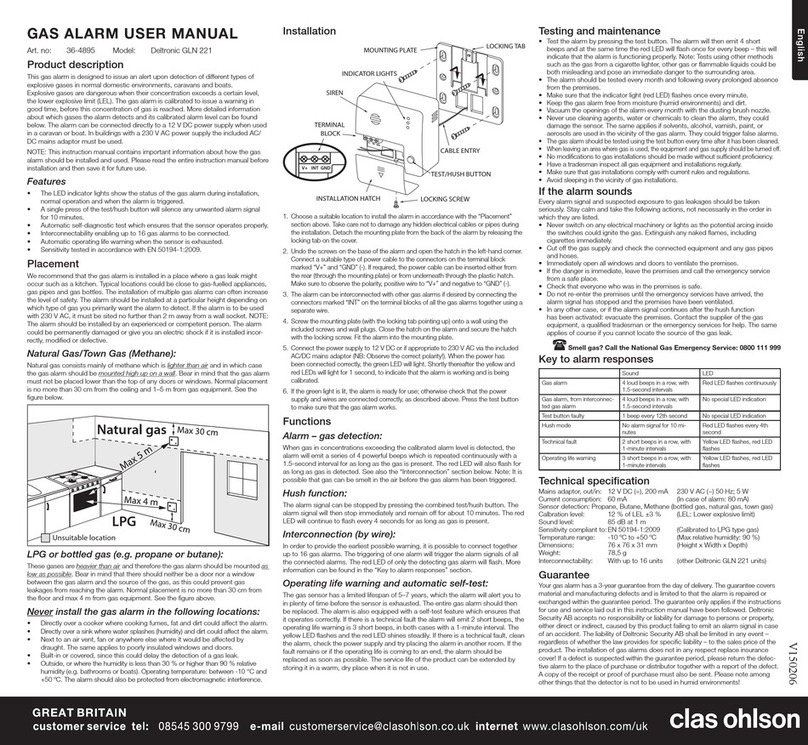
Clas Ohlson
Clas Ohlson Deltronic GLN 221 User manual
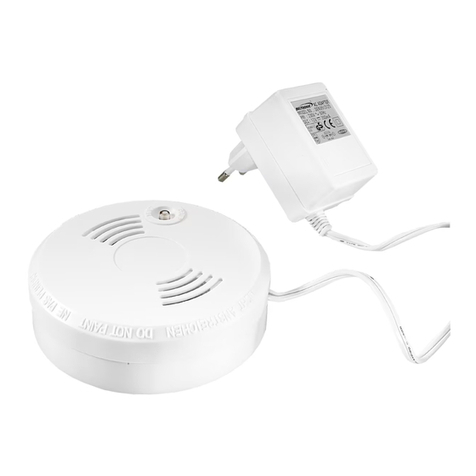
Clas Ohlson
Clas Ohlson 18-2447 User manual
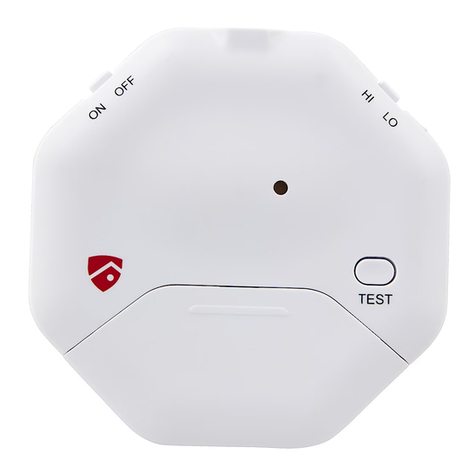
Clas Ohlson
Clas Ohlson SST-14 User manual
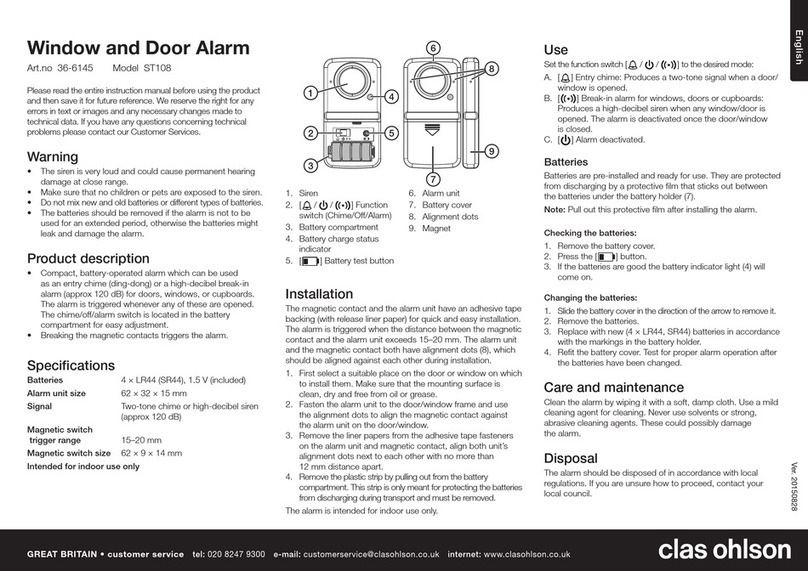
Clas Ohlson
Clas Ohlson ST108 User manual
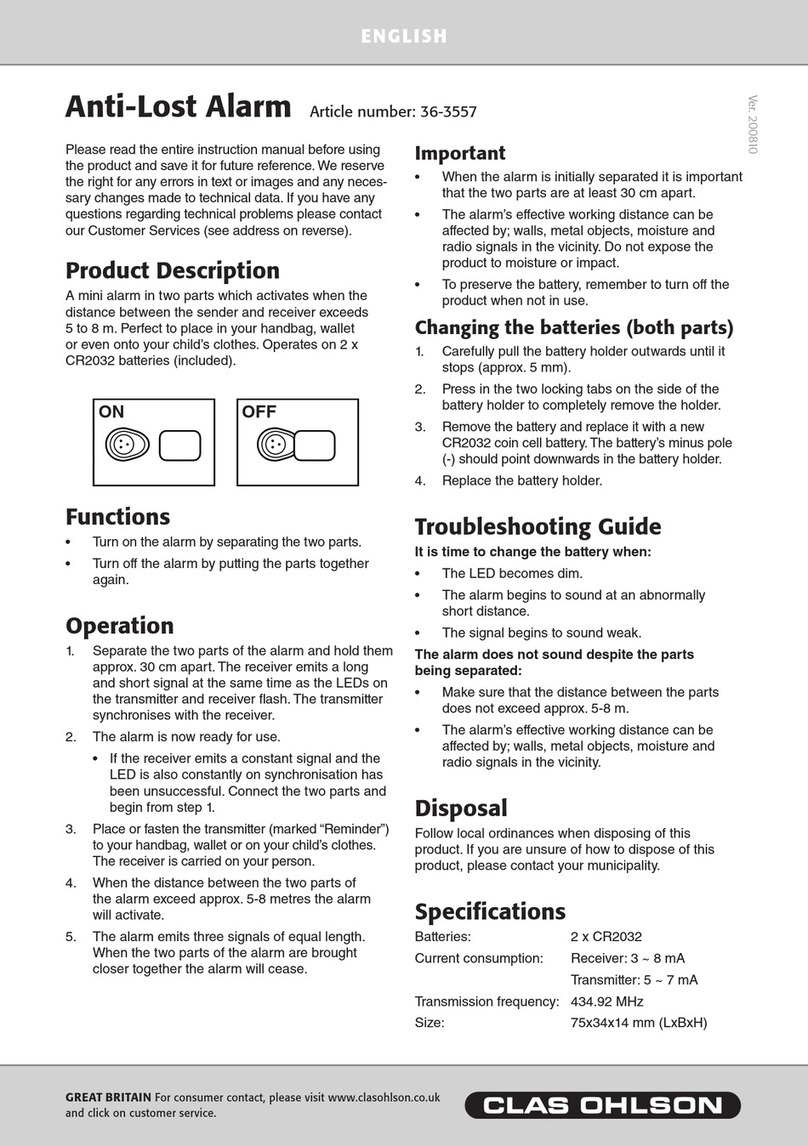
Clas Ohlson
Clas Ohlson 36-3557 User manual
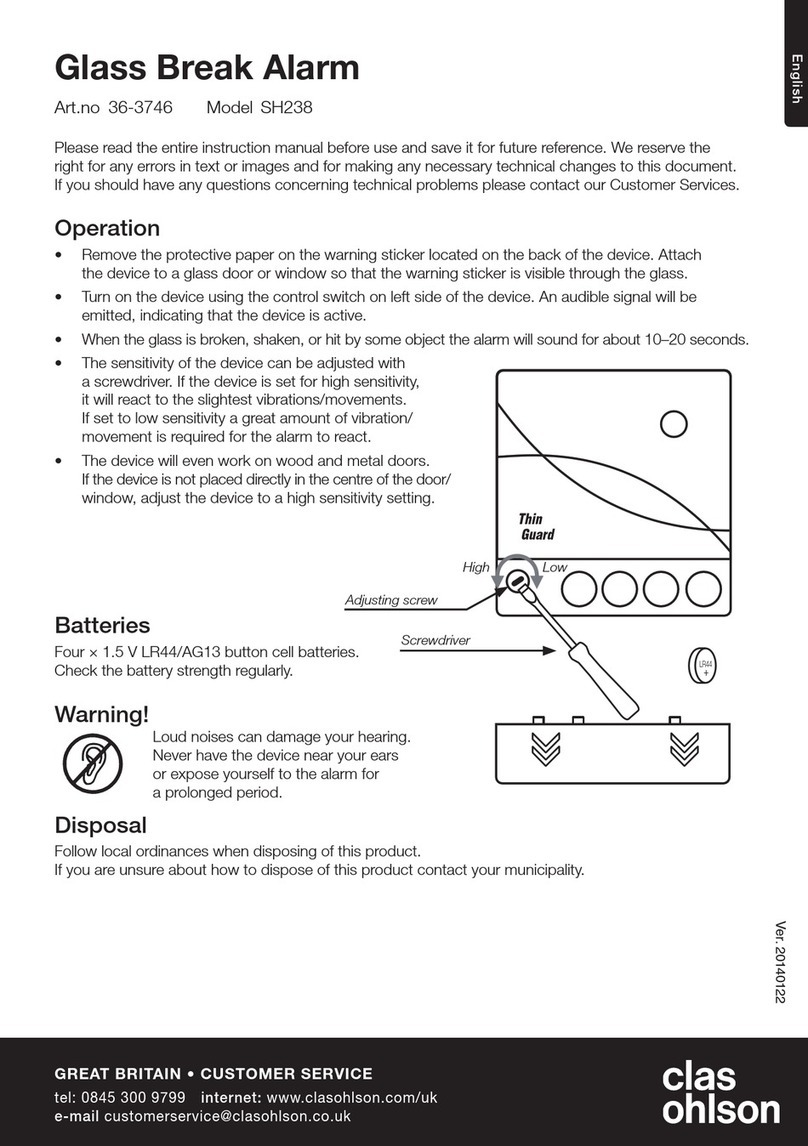
Clas Ohlson
Clas Ohlson SH238 User manual
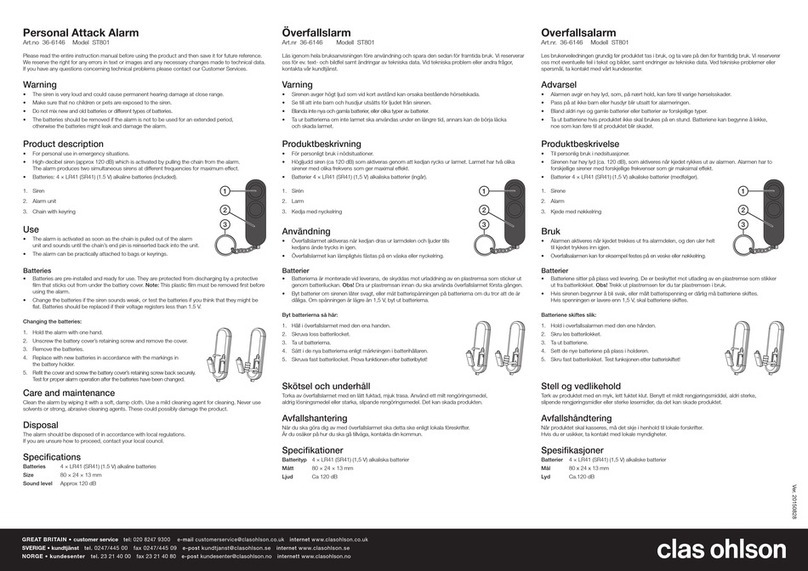
Clas Ohlson
Clas Ohlson ST801 User manual

Clas Ohlson
Clas Ohlson Z-Wave ZM1601EU User manual


